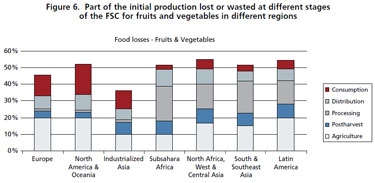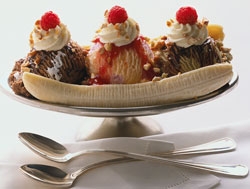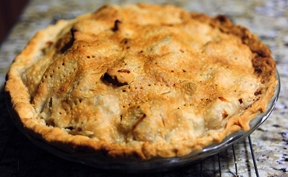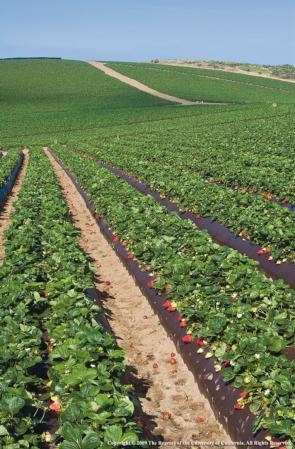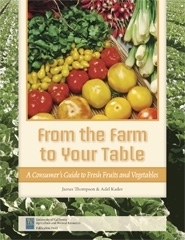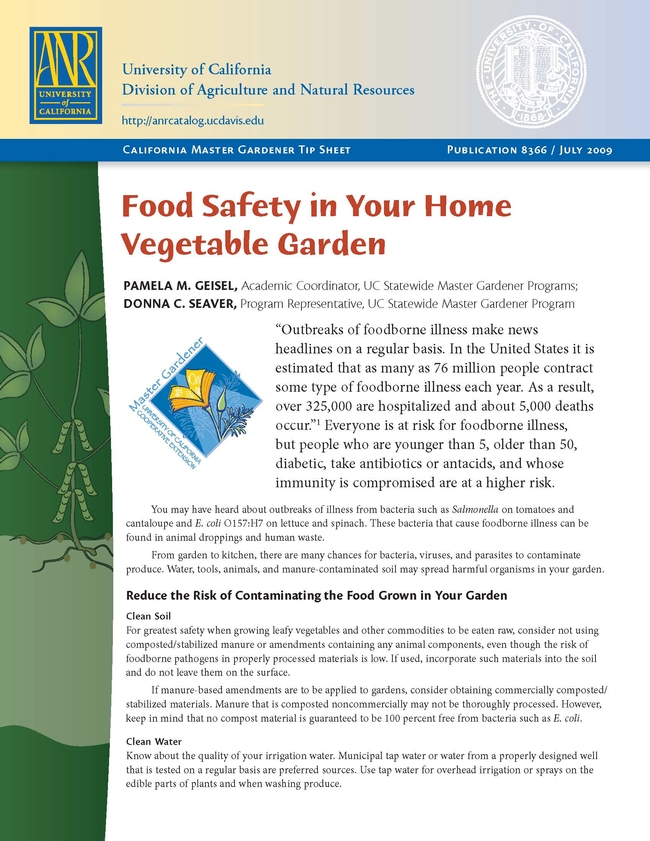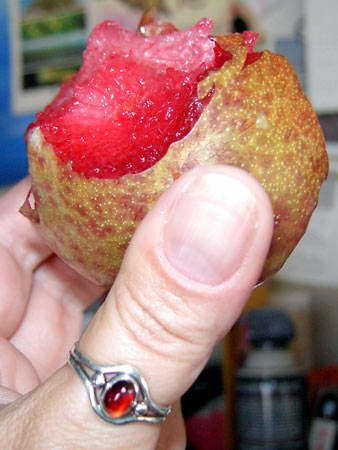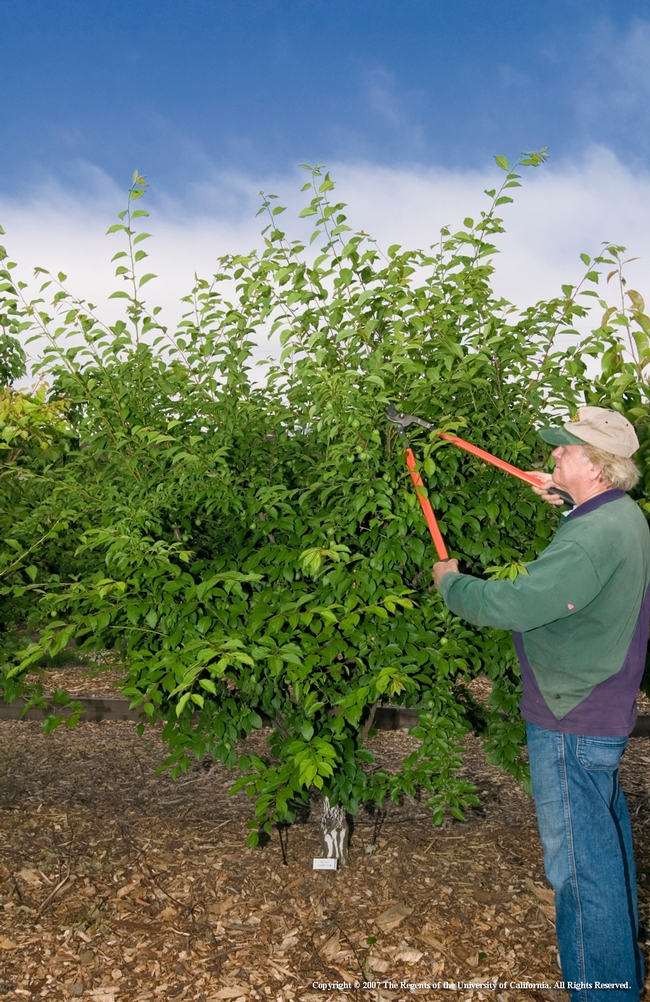UC Food Blog
It's just a waste, II
A year ago, a co-worker wrote a post on this blog entitled “It’s just a waste.” The sad facts of food waste are something we pay attention to since we work for the UC Postharvest Technology Center. A key component of our Center’s mission is to “reduce postharvest losses.” This topic also hits close to home on a personal level since I have always struggled with using up produce before it spoils. I go shopping about once a week, and tend to purchase just a bit more produce than what we will actually eat – in the hopes that one of us will suddenly adopt healthier eating habits by increasing our intake of fresh produce. I place the produce in my fruit ripening bowl, on the counter, or in the fridge, according to the recommendations on my handy produce storage chart. But nearly every week something goes awry, usually with my schedule, and I end up not serving the delicious produce-based meals I had planned, or I forget to pack my lunch, and oops, the negative effects of delayed consumption hit my produce.
The numbers show I’m not alone in this struggle, since research reports that nearly 30 percent of all produce losses in the United States happen at the consumer level. I was surprised to learn that today the average American consumer wastes nearly 50 percent more food than we did in the 1970s. (Link to the August 2012 Natural Resources Defense Council Report.) In the Food & Agriculture Organization of the United Nation's chart you can see that consumers from every other region around the world do significantly better than we in using their produce.
I want to do better, too! I hereby resolve to try harder to stick with my menu plan, pay closer attention to produce on the counter and the fridge (sometimes known affectionately in the produce industry as the “black hole”), and I will try very hard to be more creative in my use or preservation of quickly ripening produce.
My single biggest challenge is bananas. I try to buy a smaller hand of 5 to 6 bananas with some green tint left. They go on my banana hook in a cooler corner of my kitchen. At least half the weeks of the year those bananas have black spots within 3 to 4 days, and by day 5 there are usually 2 to 3 bananas left that are no longer appealing to my family. So almost half the bananas I buy usually don’t get eaten. I know, I know, “buy a smaller hand of bananas,” you say. That’s easier said than done, at least at the markets in which I shop.
Thankfully there are many cooks out there willing to share their recipes for creative ways to use up an over-supply of bananas. Below is a starting list of ideas that I’ll be drawing from as I make an effort to reduce produce waste, and especially banana waste, in our home.
- Slice into 1-inch chunks, freeze in a single layer on a wax paper covered cookie sheet. Transfer into a zip-bag and return to the freezer to use as needed for fruit smoothies or other cooking projects
- Banana bread or banana muffins
- Homemade banana ice cream
- Banana layer cake with cream cheese frosting
- Slice lengthwise, sauté in butter and ¼ tsp. rum flavoring until golden brown, and serve on ice cream
- Banana crunch cookies
- Make banana pancakes, add chocolate chips if desired (here’s a link to a pancake recipe called “Chunky Monkey” my son-in-law likes to make)
- Peel, insert a lollipop or popsicle stick and freeze. Eat as is, or dip in melted chocolate.
- Banana drop cookies
- Slice, dip in fresh lemon juice, and dry in a dehydrator
- Make a warm spiced banana topping that’s great on ice cream or gingerbread
- Banana oatmeal bar cookies
- Banana pudding
- Fruit Skewers
- Bananas Foster
- Banana Daiquiri
- Tropical banana bar cookies with raisins, pecans and coconut
- Banana cream pie
- Peanut butter, banana and rum bar cookies
- Trifle
- Burrito Bananas Foster
- Fruit Salad
- Banana crepes
- Dessert Pizza
- Banana Bundt cake with caramel frosting
- Fruit salsa, served with cinnamon tortilla chips
- Banana split
- Strawberry-banana parfait with yogurt and granola
Cherish the Gravenstein
If an apple a day keeps the doctor away, what does a Gravenstein apple pie do?
It causes a stampede to the dining room table, that's what it does. Expect to see chairs overturning, plates flying and forks spinning.
That's because Gravensteins make the best pies. As any apple pie aficionado will tell you: the best pies are the "G" pies: Gravenstein (first) and Granny Smith (second).
The Gravenstein apple reigned as the preferred apple on our family farm in western Washington. We found the sweet-tart apple "perfect" for eating right off the tree, or made into pies, applesauce and apple cider. The cows liked them, too. A gentle nudge on the tree, and - eureka! - apples would magically fall to the ground. Talk about happy cows!
This heirloom apple also reigns supreme in Sonoma County. Just ask the Gravenstein apple farmers, area residents, restaurants and the tourists who line up to buy a bag or two.
That's because of its flavor, its propensity for being in the right place (pie) at the right time, and its short season make it even more treasured. Plus, this is an apple with an aroma. The delightful fragrance will permeate your kitchen.
It's a short, squatty looking apple, streaked with red. Sometimes Nature's paintbrush turns the thin streaks into thick bands. And the stems are short - so short and so susceptible to falling from the tree that, "growers estimate they lose 40 percent of their apples even before they are ripe," wrote Carolyn Jung of The Day newspaper, New London, Conn., in her interview with Paul Vossen, UC Cooperative Extension advisor in Sonoma and Marin counties, for a Sept. 8, 1999, article.
First described in 1797, the Gravenstein originates from Denmark, where it's known as "Gråsten." It took a couple of centuries to do it, but in 2005, Denmark declared it the "national apple."
How did it get to Sonoma County? Russian trappers first planted it there in 1811. The good citizens of Sonoma so liked the apple that they named a major artery the "Gravenstein Highway." Over the last six decades, however, "Sonoma County's Gravenstein orchards have declined by almost 7,000 acres and are currently down to 960 acres," according to an article on the Slow Food USA website.
Why? Farmers find it more profitable to grow grapes.
Also, it's not an easy apple to market. It's an early variety with a very short season, usually during a few weeks in August. Blink and it's gone.
And, it's an apple you won't find in your local produce section, tucked among the Red Delicious, Galas, Fujis, Pink Ladies and Granny Smiths.
"They don't travel well, and they don't last long (short season)," says Daniel Sumner, professor in the Department of Agricultural and Resource Economics at UC Davis and director of the UC Agricultural Issues Center. "To consumers, this is the kiss of death."
Enter the Slow Food movement. To help preserve the heirloom apple, the Russian River Slow Food group contacted area restaurants and asked that it be featured in their desserts. Getting into the preserve-the-Gravenstein act, the FruitGuys, a company that ships organic fruit to customers, donated 17 percent of this year's proceeds back to the Gravenstien apple farmers.
Every little bit helps.
In the meantime, Sebastopol continues to celebrate its annual Gravenstein Fair; this year the event took place Aug. 11-12.
In search of Gravensteins, we drove to Sebastopol on Sunday, Aug. 19, just as the season was about to end. "Ours will be gone in a couple of days," a farmer told us.
"Which apple makes the best pie?" we asked. "Granny Smiths or Gravensteins?
"Gravensteins," the farmer said. "Hands down."
We agree.
Here's our family recipe for Gravenstein apple pie. We favor using brown sugar instead of granulated white sugar. And we mix the brown sugar with cinnamon and nutmeg.
Crust for 9.5-inch pie
2 cups flour
1/2 teaspoon baking powder
2/3 cup butter-flavored Crisco, chilled
3/4 teaspoon salt
6 tablespoons water, cold
Sift flour, baking powder and salt. Mix in Crisco until the dough pieces are pea-sized. Add cold water as needed, 6 tablespoons or more, and form into a ball. Roll out dough into a circular shape and invert on pie pan.
Filling for 9.5-inch pie
8 cups of apples, peeled, cored and sliced
1 teaspoon cinnamon
1/2 teaspoon nutmeg
3/4 cup loosely packed brown sugar
1-1/2 tablespoons of butter
Preheat oven to 425 degrees. Gently mix together (with fork) brown sugar, cinnamon and nutmeg and then mix lightly through the apples. Before pouring the mixture into the pie pan, sprinkle a little cinnamon (less than 1/4 teaspoon) on the lower crust. Dot the heaping apple mixture with thin slices of butter. Place top crust on pie. Slit with sharp knife in several places and poke with prongs of fork. Sprinkle a dash of nutmeg on the crust. Line the edge with 1/2-inch strip of aluminum foil to prevent excessive browning. Bake at 425 degrees about 50 minutes or until the crust is lightly browned and the apples are cooked through. Test with fork.
Warning: the aroma of this pie will attract all the neighbors, their families, their friends and their friends' friends.
No wonder Luther Burbank said that “if the Gravenstein could be had throughout the year, no other apple need be grown.”
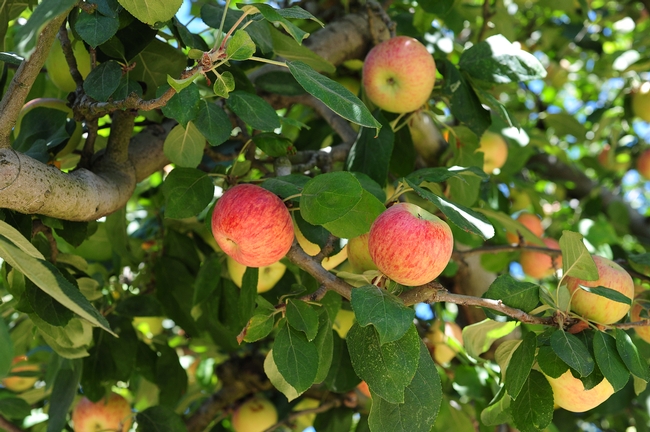
Gravenstein apples hang from a tree in Sonoma County. (Photo by Kathy Keatley Garvey)

Gravensteins are usually streaked with red, but Nature's paintbrush created this effect. (Photo by Kathy Keatley Garvey)
Postharvest technology is something of a mystery
Postharvest technology. Hmmm. What does that even mean to you? Like most people, you’ve probably never thought about it, but it actually affects you every day. At least whenever you eat fruits and vegetables, and let’s face it, we all need to be eating more fruits and vegetables.
Working at the Postharvest Technology Center, I often think about how to spread our mission of how to reduce postharvest losses and improve the quality, safety and marketability of fresh horticultural products. Part of doing this is educating consumers about making good choices so they have a better experience eating fruits and vegetables. And, if consumers have a better experience with fruits and vegetables, we eat more of them. If we can create demand at the consumer end, it will trickle through to the people that handle your produce: processors, retailers, distributors, carriers, marketers, shippers and finally growers.
I spoke with Jim Thompson, who wrote “From the Farm to Your Table: A Consumer’s Guide to Fresh Fruits and Vegetables” along with Adel Kader, two distinguished experts in the field of postharvest technology. Thompson said they wrote the publication knowing that, “For most consumers, it’s kind of a mystery what influences the quality of their produce. This publication answers some of the questions of how to make good choices at the market and at home.”
Thompson adds, “There are many things that can steal quality from produce. And it starts at the farm.”
The type of cultivar the farmer chooses to plant and what kind of soil, temperature and light conditions, irrigation and fertilization practices at the farm affect flavor and nutritional quality. When the product was harvested, how it was handled prior to arrival at your market, and how your market stores the product all influence the quality of your produce.
You certainly know which market in town has the best produce section, and it’s important to you. In fact, according to the 2011 National Grocers Association Consumer Survey Report, “Consumers say they are keeping health a priority—and 91 percent regard a stellar produce department as a ‘very important’ factor in where they buy groceries. This is precisely the same percentage as a year ago, which represented a dramatic five-point jump from the 86% level of two years ago. While the recession may have withered wallets, it hasn’t hurt consumers’ resolve on this measure.”
If you’d like to learn more about how you can make the most of your fresh fruit and vegetable experiences, the Postharvest Technology Center is offering a 40 percent discount (making it only $4.20!) on “From the Farm to Your Table” through the end of September 2012. And as long as you’re there, our other consumer publication, the poster “Storing Fresh Fruits and Vegetables for Better Taste” (just $1) would be a lovely addition to your refrigerator!
Please contact us at (530) 754-4326 or postharvest2@plantsciences.ucdavis.edu if you’re interested in ordering multiple copies for a nutrition, health or cooking class or you can purchase them through our online bookstore.
Food safety for the backyard garden
We're used to hearing news about food safety issues in the commercial food supply; from spinach to cantaloupes, consumers keep a watchful eye to make sure that the food they bring home from the market is safe for their families. But how much thought do you give to the safety of the fruits and vegetables from your backyard?
Many home gardeners assume that just because the food came from their own backyard it is safe. But that's not always the case.
The free UC ANR publication Food Safety in Your Home Vegetable Garden is a terrific guide to reducing the risk of contaminating the food grown in your garden. From clean hands, tools, and water to the careful use of compost and manures, you'll find easy-to-follow tips on how to keep your garden's bounty safe from planting to harvest. An extensive list of online resources, including many other related UC ANR free publications, is included.
This publication is also available in Spanish - La seguridad alimentaria en su huerto familiar.
In the backyard orchard, pluot reigns supreme
When it comes to planting stone fruit at home, pluots are the way to go, says Chuck Ingels, UC Cooperative Extension advisor in Sacramento County. Cherries are delicious, but with a new maggot pest, are hard to grow. Peaches and nectarines are susceptible to leaf curl disease, which is challenging to manage because the most effective products have been removed from store shelves. Apples and pears can suffer from fire blight and coddling moths worms.
“I think plums and pluots are the best choices for backyard trees,” Ingels said. “Especially pluots.”
“Pluot” is a trade name for varieties of interspecific plum-apricot bred by private Modesto breeder Floyd Zaiger. Pluots’ skin is typically dappled but smooth and without the bitterness in the skin of plums. The flesh is unusually sweet and juicy with complex plum-apricot flavors.
“I really like Flavor Grenade,” Ingels said. “The taste just explodes in your mouth. Another good one is Dapple Dandy, which is a little later.”
Flavor Grenade is a large fruit with oblong shape. The skin has a red blush on green background, and the flesh is a juicy yellow. Dapple Dandy has mottled pale green to yellow, red-spotted skin and red or pink juicy firm flesh.
About a dozen varieties of pluot are offered by Dave Wilson Nursery of Modesto, Zaiger’s exclusive licensee. Dave Wilson Nursery supplies bare root trees in the winter to retail nurseries across California. The best time to plant is early- to mid-winter.
At the UC Cooperative Extension Fair Oaks Horticulture Center in Sacramento, Master Gardeners are creatively planting and pruning pluots and other fruit trees to make them easier to harvest and take less space.
“We have fruit bushes at the horticulture center,” Ingels said. “It works out really well.”
Fruit bushes are standard or semi-dwarf trees kept small by periodic summer pruning. Fruit bushes can be managed without a ladder and multiple species and varieties can be grown in relatively small areas. When bare-root planted in the winter, the trees are headed to knee height. In late spring and again in the summer, new growth is cut in half. This pruning regimen continues until trees reach the desired height - usually two years. For the life of the tree, it is pruned to a size manageable from the ground.
“The main concern is keeping them tame,” Ingels said. “For pluots, there is just one dwarfing rootstock – Citation.”
Pluots, like plums, will also need a pollinizer of a different variety to ensure good fruit set. Most pluot varieties will pollinize another pluot variety. Another option is planting certain varieties of plum to pollinize the pluot.
At the Fair Oaks Horticulture Center, Master Gardeners are experimenting with a number of planting arrangements, such as planting two to four different trees in one hole. Trees grown in this close proximity combine to form a bush the approximate size of one tree grown alone. For more ambitious gardeners, fruit trees can also be carefully trained into an espalier or other design. For examples, see the Fair Oaks Horticulture Center website.


